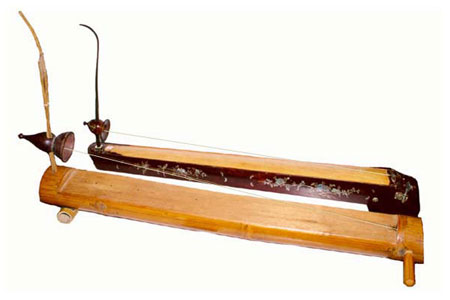Dan bau is a musical instrument that touches the heart. The music of dan bau (one-stringed zither) should be solely for the pleasure of its player. Don't listen to it if you are a young woman.

This warning, probably coming from vigilant parents wishing to protect their daughters from the emotional appeal of love songs played on this instrument; this gives an idea of the power and charm of its music.
According to the "Dai Nam thuc luc tien bien" the first dan bau was made in 1770. At its first appearance it was a very simple instrument comprised of a bamboo section, a flexible rod, a calabash or half a coconut. After a process of evolution and improvement, the present form of the dan bau is a bit more sophisticated, yet still quite simple. It consists of an oblong box-shaped sound board, slightly narrower toward one end, with a slightly warped top made of unvarnished soft light wood, sides made of hard wood, and a bottom of light wood pierced with holes for better sound. At one end of the sound board is a flexible bamboo rod that goes through a dried calabash whose bottom end has been cut out before being fixed on the sounding board. At the other end of the sounding board is a peg made of wood or metal used for tuning. The metal string is attached to the rod and to the peg. The pluck is a pointed stick of bamboo or rattan.
The dan bau is usually tuned to the note C. It uses harmonies (or overtones). When playing the musician plucks the string while touching it lightly with the side of his hand at a point producing a harmony. But because the flexible rod causes the tension of the string to vary, the pitch may be made to rise or fall, the note may be lengthened or shortened, and trills may be played. The technique involving the fingers of the left hand includes vibrating, pressing, alternate pressing and releasing. The dan bau may be played on a scale consisting of third-tones or even quarter-tones.
The notes played by the dan bau are smooth, sweet, and captivating. In recent years success has been achieved in amplifying the sound, causing an increase in volume and distance that the sound carries, while still preserving the quality of the sound.
The instrument is played solo or to accompany a poetry recital. During recent years, it has taken a role in orchestral accompaniment to cheo and cai luong opera. The dan bau has been performed on major stages in foreign countries.